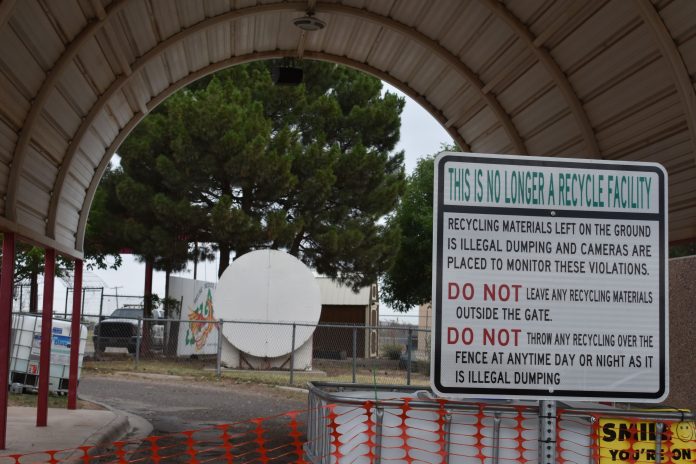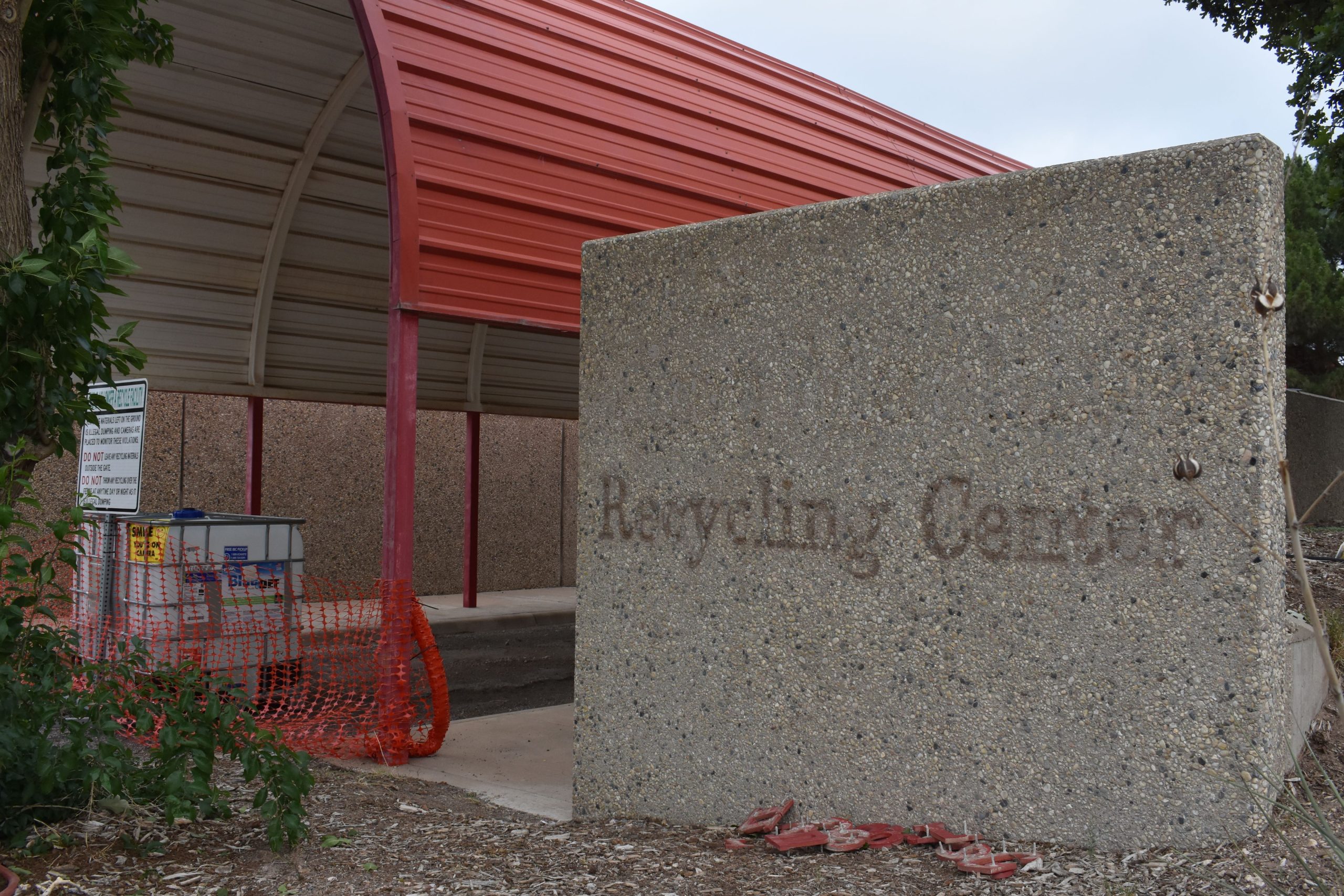
Earlier this month, the Odessa City Council rejected a recycling contract with BRI, Inc., and opted not to sign a contract for SOS Waste Disposal to haul recyclables from the Time Machine to BRI in Midland, signaling an end to recycling in Odessa.
Out at the Time Machine recycling center on 42nd Street, city workers posted a sign stating it was no longer a recycling facility and anyone who left recycling materials there would be guilty of illegal dumping. City workers also pried letters spelling out “Recycling Center” from a Time Machine wall.
Now it appears as though the city council has had second thoughts.
On Tuesday night Interim City Manager Agapito Bernal announced the city is “actively working towards re-establishing the recycling program, but it has to find a viable path that works for the city.” He said the city is considering placing recycling bins for cardboard and plastics at the Time Machine.
For months, the council has discussed the fact Third World countries are no longer taking recyclables and much of Odessa’s materials are contaminated. They also noted a cost-benefit analysis showed the cost was too high due to overtime expenses and the need for a new multi-million dollar sorting facility and bailer. The council expressed their belief the $350,000 set aside to design the facility would be better spent elsewhere.
Back in February, Public Works Director Tom Kerr said the city disposes roughly 100,000 tons of garbage a year and about 700 tons of recyclables.
Solid Waste Superintendent Jesse Rodriguez told the council his staff was picking up 336 commercial recycling bins on Saturdays because of a staffing shortage and were being paid overtime to do so. BRI Recycling Services was then sorting through the materials mid-week and city staff was taking the remaining refuse to the landfill on Fridays. In other words, the city was picking up the same refuse twice.
The city council ultimately decided to remove those 336 bins and convert them into trash containers. City staff anticipated the conversion would net the city an extra $250,000.
The council also directed Kerr to work with BRI so there would be less contamination happening with the materials being dropped off by residents.
In March, Kerr told city council members he and BRI had discussed the possibility of putting up $125,000 in new fencing at the Time Machine, purchasing more 30-yard recycle containers and removing a divider wall to accommodate the containers. All of the measures, he said, would help with contamination.

The council agreed to consider that proposal and council members directed Kerr to go out to bid in the hopes of finding another, less-expensive company to haul the materials from the Time Machine to BRI’s Midland facility.
On May 9, the council rejected BRI’s contract proposal and SOS Waste Disposal’s proposal to haul recyclables from the Time Machine to BRI in Midland.
Mayor Javier Joven said he wished recycling was cost effective, but it just isn’t and it’s only going to get more expensive.
“If people still want to recycle they’ll still be able to recycle. Just the City of Odessa, in my opinion, doesn’t need to be in this business any longer. For the reason is just doesn’t make financial sense,” Joven said. “We can increase our savings by bowing out and allowing people to find their own methods of recycling.”
The mayor said the city needs to focus on fixing the roads and paying firefighters, police officers and other city staff.
“I want to be able to do research. I want to be able to provide it, but the thing is, it doesn’t make economic sense at this point,” Joven said.
During Tuesday night’s meeting, Joven insisted he was not “backtracking” and the city is exploring potential partnerships with another company which has its own facility.
On Wednesday, Joven said he heard Basin Disposal might be a viable option for the city more than 18 months ago and he hopes to sit down with them to discuss a possible partnership soon.
TIRZ
In other matters Tuesday, the idea of disbanding Odessa’s Tax Increment Reinvestment Zone Board was floated after TIRZ Board Chairman Craig Stoker was asked to provide council members some background information on the board’s work.
The TIRZ is a special zone created by the city council in 2019 to attract new investment in an area. The taxes paid into the zone by Medical Center Hospital, Odessa College and the City of Odessa are supposed to be used to finance public improvements in that area.
The board is comprised of six council appointees and three appointees selected by MCH, OC and the City of Odessa.
Stoker told the council the TIRZ was predicted to raise about $9 million over 20 years, but so far, it’s only raised about half a million. There’s approximately $330,000 in the bank right now and the rest was spent on updating the downtown master plan, rehabbing parking lots at Fourth Street and Grant Avenue and 12 flowerpots placed along Grant.
“The other projects we’ve looked into have either been too expensive or we need further instruction,” Stoker said.
Once the downtown master plan was updated, Stoker said the board turned its attention to vetting companies who could design a downtown festival street. They recommended KDC Associates, which the city council hired for $640,000 and later fired.
“So again, we’re just kind of in a holding pattern because there’s just not a whole lot we can do without money or without the projects being properly vetted by the city,” Stoker said.
TIRZ board member Wallace Dunn told the council the hospital would vote in favor of disbanding the TIRZ if asked today. Although the hospital is in the downtown area it hasn’t benefited from it at all, he said. The flower pots mentioned by Stoker stopped two blocks short of the hospital.
Jeff Russell, TIRZ vice chairman, also expressed his desire to disband the zone and distribute the remaining funds back to the city, OC and MCH.
“I don’t want it to be construed as talking bad of the TIRZ board, but I think the overall scheme of the TIRZ is highly flawed and I question the value of it,” Russell said.
Many of the buildings located in the zone are government-owned buildings, buildings that don’t bring in tax revenues and there are other entities who can participate in beautification projects, Russell said.
“I think overall when you look at the overall scope of the challenges that all of our taxing entities are faced with financially, there’s an endless multitude of things that really are critical, that need to be done across our city,” Russell said. “I guess philosophically I (also) don’t like the idea of separating this area of town from that area of town and trying to do these little carve outs and everything. I think we’d be better off looking at our city as a whole and and letting you guys decide, as our elected council where we need to best spend our money.”
Russell and the mayor both expressed their disgust that money was spent updating the 2016 downtown master plan, saying the updated plan merely “regurgitated” the old one.
Joven also repeated his long-held belief that it’s ridiculous for the city to spend $7 million on a proposed downtown festival street that will be two blocks long.
He also insisted that downtown, despite many people’s insistence, was not included in the $93 million certificate of obligation passed in August 2019. City attorney Dan Jones backed up the mayor’s statement.
“So the thing is, my question is, how can we get to that point? Legally how did we get to that point? How was this never discussed?” Joven asked. “So, the thing is, in order for this council to move forward, it has to correct that…we are burdened as taxpayers to pay this debt back, then we should be able to make the greatest impact possible. I still disagree that $6.5 million will go into two blocks because we want to have a huge impact. There is no abandoning of the downtown revitalization, but we have to designate it legally, which had not been done.”



